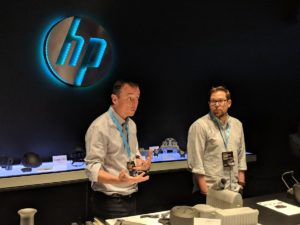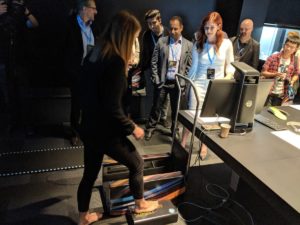As technologies continue to advance, they often focus on the human experience, and in maintaining and enhancing human agility. Footwear in particular is benefiting from trends toward not just customization, but personalization, as every foot and every gait is unique. Supporting each individual’s way of walking allows for a better overall experience, and companies like Brooks are taking significant notice.
Brooks, which has been working with FitStation powered by HP, introduced Genesys, its first personalized high-performance running shoe, at last week’s HP Global Innovation Summit. The panel on immersive computing brought together FitStation partners HP, Brooks, and Superfeet in a discussion regarding a personalized future for footwear drawn from a data-driven solution platform. Following the panel conversation, I appreciated the opportunity to sit down with Tricia Dugan, VP and Head of Global GTM, Immersive Computing, HP; Pete Humphrey, VP of R&D, Brooks; and Patrick Pons de Vier, SVP, Global Footwear, Brooks.
When journalist Tanya Weaver and I spoke with the trio, I had to confess that while I am familiar with Brooks through their work with FitStation and dedication to bringing advanced technologies into running shoes, I am personally not at all a runner. Brooks keeps the idea of “Run Happy” behind all they do, though, and perhaps if everything about the experience of running was improved, I might be inclined to change my mind.
“Customization is cool, but personalization is fantastic,” Pons de Vier said of an enhanced running experience.
“We believe it’s not enough. It’s very much about addressing what you need, what your body needs, what you want as an experience. Using this new platform, powered by HP, provides new solutions for a personal fit. The feel that you want, more cushion or more springy, the right support where you need it, all for the shape of your feet — that’s real customization. At the end of the day you have a better experience. What Brooks has had in mind for more than 20 years is that, is the shoe for you. We look at adaptability, at engineering. It’s not the same game, to adapt or to really propose something truly personalized. HP and FitStation propels us to success in personalization. It’s going to change totally the relation with your shoe, with your running experience.”
While many of us are used to just going to the store (or browsing online) and pulling an appealing pair of athletic shoes based on the size on the box, there is a better way — or there will be. It’s very common for an individual’s feet to be slightly different sizes or shapes, with one arch perhaps higher (my right arch is higher) or one foot a bit longer, impacting fit. That’s if the numbers on the box mean much at all, anyway. During the panel session, Pons de Vier proclaimed, “Shoe size is dead. It’s your size.”
Beyond sizing comes another important metric for appropriate footwear; athletic shoes aren’t meant for sitting around the house, but for dynamic movement. Each individual moves differently. I know that my stride is long, for example, but not really what that means for how my foot falls on the ground with each step. Putting more weight on the inside or outside, or ball or heel, of the foot impacts gait and potential for stress-related injuries. Building a shoe in response to individual stride represents a next-level attention to the customer, to the runner.
“When we look at what we’re building, we’re looking at your gait, your pain,” Humphrey told me. “We figure out through our system why that’s occurring. In the beginning it won’t be perfect, but it will get there. Then we think about how to apply those things to personalize a product for you.”
Starting with 3D scanning a foot, the system may evolve to be a larger solution to encompass whole-body modeling. With better understanding of the entire body, a fuller simulation can be built up to respond to more unique needs. FitStation was designed with dynamic analysis in mind, and the team at Brooks is keen to explore more about how this could impact more personalized service.
“The more information we have about you, how your body moves, we can plug into a model and create a better product,” Humphrey continued.
That increase in data collection of course allows for a better individual customer experience in creating personalized products — and it also enables the company collecting that data to build up a stronger understanding of the variety in human bodies, the dynamics with which movement takes place.
“While this data makes a better shoe for you, it creates more data for the system, more biometric data. This makes even your mass production better. With this volumetric data in mass quantity, we can lift the industry in even a mass space. We’re starting with foot scanning, and thinking about the future with body scanning. Look at clothing measurement; with more data about people’s bodies, footwear and clothing would be better,” Dugan elaborated.
“FitStation is a platform that incorporates many products, working with many partners. One unique thing we’ve done with FitStation is security, building trust within the platform, compute processing, 3D capture, all that we’ve been developing for years within HP — we’ve integrated all these pieces together, all the way through the manufacturer. We’ve integrated all these pieces into a central hub, and data can be doled out within this hub, but private within each container. Brooks has its own container, other brands have their containers. The vision in the platform is that entire process knitted together, including all those things HP is best at from a technology perspective. We’re in a unique position.”
Having HP’s technology at the heart of the platform allows for partners to build on trusted technologies, bringing their own expertise to the plate in furthering collaborative goals as well as those for their target demographics. For Brooks, runners are absolutely in focus, and the company has been working for years to enhance the experience.
“We’ve been on this mission for a while,” Humphrey noted. “We’ve been working with individual partners, trying to piece all this together ourselves. It’s difficult to do, to combine all these worlds. What HP is bringing with the FitStation platform has made life a lot easier.”
Pons de Vier added that a couple of specific styles are to go through FitStation, offering the ability to test different aspects and get feedback that will prove to be “very important for the long run.”
“The big point for us is that it’s a learning process; we’re asking our community to learn with us and create a product,” Humphrey continued. “The testing side is rather complex; we have to go through each step, link up each individual and work with them, get that individual’s feedback.”
That hands-on approach with each customer is creating a valuable cache of feedback to draw from in continuing development as personalization ultimately works toward a scale solution.
“This solution drives a data-driven approach away from the cobbler, away from that by-hand measurement,” Dugan affirmed.
As we examined the Genesys shoe, Pons de Vier noted that “People stop running because of injury, which is a shame,” and that Brooks is working to customize, to personalize these shoes in order to proactively avoid running injuries. The technology used in creating Genesys and enabling personalized high-performance running shoes is setting Brooks up to carry through on its mission, for a pain-free experience allowing customers to indeed ‘run happy.’
For my part, I’m still not a runner. Were something chasing me, though, Genesys would be the shoes I’d want to be wearing so I could happily run my way out of that hypothetical situation.
Discuss Brooks, HP, the future of manufacturing, and other 3D printing topics at 3DPrintBoard.com or share your thoughts in the Facebook comments below.
[All photos: Sarah Goehrke]
Subscribe to Our Email Newsletter
Stay up-to-date on all the latest news from the 3D printing industry and receive information and offers from third party vendors.
Print Services
Upload your 3D Models and get them printed quickly and efficiently.
You May Also Like
Heating Up: 3D Systems’ Scott Green Discusses 3D Printing’s Potential in the Data Center Industry
The relentless rise of NVIDIA, the steadily increasing pledges of major private and public investments in national infrastructure projects around the world, and the general cultural obsession with AI have...
3DPOD 260: John Hart on VulcanForms, MIT, Desktop Metal and More
John Hart is a Professor at MIT; he´s also the director of the Laboratory for Manufacturing and Productivity as well as the director of the Center for Advanced Production Technologies....
Etsy Design Rule Change Reduces Selection of 3D Printed Goods
Online marketplace Etsy has implemented a rule change requiring all 3D printed goods on the site to be original designs. The update to the site’s Creativity Standards states, ¨Items produced using...
E-Beam OEM Wayland Additive Partners with USC Racing to 3D Print Titanium Exhaust Collector
Every year, standards organization SAE International holds a competition called Formula SAE, in which students from both undergraduate and graduate programs design, build, and race small formula-style race cars. For...







































